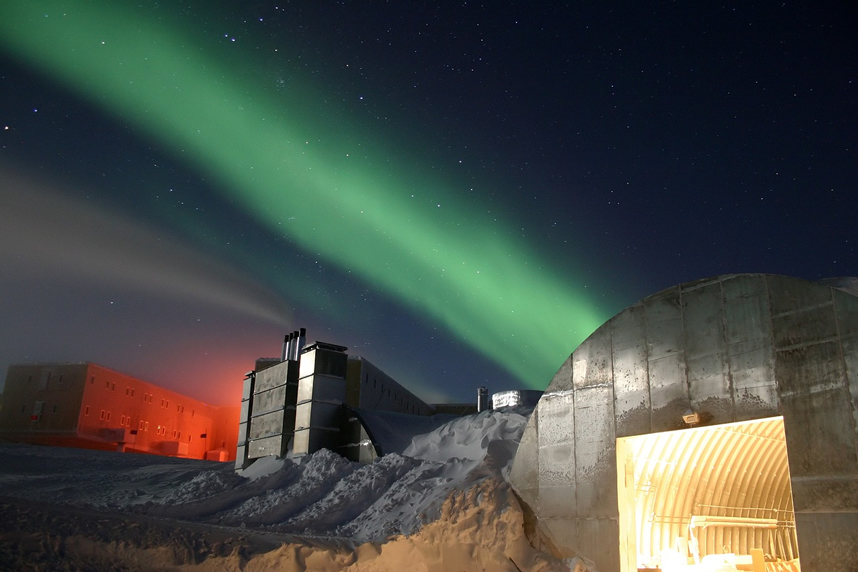Amundsen-Scott South Pole Station
The South Pole station was built in phases, so the first group of occupants was able to take up residence in January 2003, and it was officially inaugurated in January 2008. Entire summer operations began in October 2011. The 6039-sq-meter elevated station stretches 128m, facing the prevailing winds with an aeronautical design that helps scour snow from beneath it. The complex accommodates 150 people in summer and 50 in winter.
Flexible walkways connect two blue-gray, horseshoe-shaped modules and can be raised on stilts to prevent destructive snow buildup. The main entrance, sometimes called ‘Destination Alpha,’ faces the skyway. Another staircase entrance at the back of the station is ‘Destination Zulu.’
One module houses living quarters, a dining room, a bar, a hospital, a laundry, a store, a post office, and a greenhouse (adding to the futuristic, space-station feeling of the new facility, the greenhouse is officially known as the ‘food-growth chamber’). The other module includes offices, labs, computers, telecommunications, an emergency power plant, conference rooms, music practice rooms, and a gym. Cozy reading rooms and libraries are scattered throughout both units.
The station has triple-pane windows, 200kg stainless-steel outside ‘freezer’ doors, and a pressurized interior to keep out drafts. At one end, a four-story aluminum tower, familiarly known as ‘the Beer Can,’ contains a stairwell, a cargo lift, and utilities. Photovoltaic panels take advantage of the summer’s 24 hours of sunlight. One wind turbine was added in the 2009–10 season, but the light winds of the Polar Plateau mean that the station would require a much larger windmill farm to support its needs.
Before this station existed, from 1975 to 2008, home at the Pole was known familiarly as ‘the Dome,’ or, affectionately, ‘Dome, Sweet Dome.’ Built from 1971 to 1975, the former base was a silver-gray aluminum geodesic dome, 50m in diameter at its base and 15m high. It covered three structures, each two stories high, which provided accommodations, dining, laboratory, and recreational facilities. Although the Dome protected these buildings and their occupants from the wind, it did nothing about the cold – it was unheated. It had a packed-snow floor and an opening at the top to let out water vapor. Over time, as the base became submerged in snow and ice, parts of the complex became unsafe. Occasional power brownouts and fuel leaks threatened station security, and the drifting snow began to crush the Dome. Because of all these problems, the US government built the current above-snow facility.
The old Dome complex was dismantled over several years, with the final pieces removed in 2010 and shipped to Port Hueneme, California, where the top portion sits in the new Seabee Museum.
Work on the Pole’s current US$ 174 million station began in 1997 and required 80 construction workers (25% women) to work nine-hour days, six days a week. In the 24-hour summer daylight, three crews worked shifts round the clock. Workers described how metal burnt bare hands like a hot stove among the unusual construction hazards here. Meanwhile, the station’s average winter population nearly doubled with the extra staff devoted to construction. Hundreds of flights from McMurdo brought in the necessary building materials, which had been planned, procured, and shipped over many years to McMurdo.
Article source

